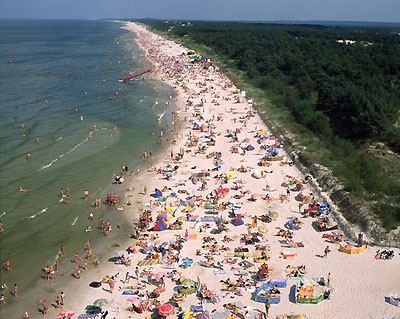Gmina Łeba (urban gmina) Website www.leba.eu Population 3,824 (2006) | Postal code 84–360 Area 14.8 km² Local time Sunday 3:32 PM | |
 | ||
Weather 7°C, Wind NW at 14 km/h, 95% Humidity Points of interest Słowiński National Park, illuzeum ‑ WYSTAWA INTERAKTYWNA, Labyrinth Park Leba, Port Łeba, Ruiny kościoła św Mikoł | ||
eba nightlife poland
Łeba [ˈwɛba] (Kashubian/Pomeranian: Leba; German: Leba) is a town in the Pomeranian Voivodeship of Poland. It is located in the Gdańsk Pomeranian region (Pomorze Gdańskie), near Łebsko Lake and the mouth of the river Łeba on the coast of the Baltic Sea.
Contents
- eba nightlife poland
- Map of Leba Poland
- History
- Sights
- Demographics
- Famous people
- Twin towns Sister cities
- References
Map of Leba, Poland
History
The Pomerelian settlement of Łeba was first mentioned in a 1282 deed. At that time the village was located about two kilometers (1.2 miles) west from the present mouth of the Łeba River. Łeba received municipal rights by the State of the Teutonic Order in 1357. Located at the Łebsko Lake at the Baltic Sea, it developed to a fishing port and a wood marketplace. With Lauenburg Land it became a Polish fief during the Thirteen Years' War in 1454, held by the Dukes of Pomerania.
Old Leba was threatened for many centuries by floods and expanding sand dunes and therefore was rebuilt in a safer location after 1558. The town fell back to the Polish Crown after the death of the last Pomeranian duke Bogislaw XIV until King John II Casimir Vasa enfeoffed Elector Frederick William I of Brandenburg-Prussia with Lauenburg Land by the 1657 Treaty of Bromberg.
With the First Partition of the Polish-Lithuanian Commonwealth in 1772, Leba was incorporated into Prussia. Soon after a large port was built on instruction of the Prussian king, whereby a 34-metre (112-foot) broad channel between the Leba lake and the Baltic Sea was dug, which however did not weather the storms on the coast. Due to its picturesque setting, the Leba seaside after World War I became a popular resort for German bohémiens. The painter Max Pechstein and other expressionists frequented the place.
In the proximity of Leba there is a large former testing area for long-range rocket weapons operated by the Rheinmetall company. On the Leba spit the German long-range rocket Rheinbote was tested between 1941 and 1945. Also the V-1 flying bomb was tested here from 1943 to 1945. Between 1963 and 1973 33 Polish sounding rockets of the type Meteor were launched in Łeba.
In March 1945, shortly before the end of World War II, the region was occupied by the Red Army. According to the Potsdam Conference, after the end of the war the town was put together with Farther Pomerania under Polish administration. The local populace was evacuated by the Nazis or expelled and replaced by Poles.
Sights
There is an abundance of architectural and natural attractions near Łeba, above all the Słowiński National Park with its moving sand dunes, about 8 kilometres (5 miles) west of the city. Further objects of interest include:
Demographics
Before World War II the (then German) inhabitants of the town were predominantly Protestants. Since the end of the war the population is predominantly composed of Roman Catholics.
Famous people
Twin towns — Sister cities
Łeba is twinned with:
